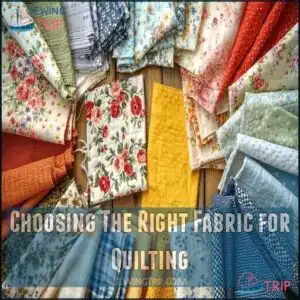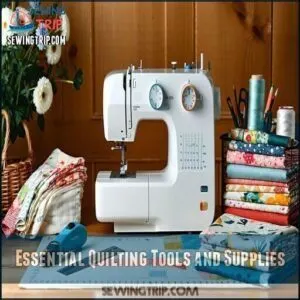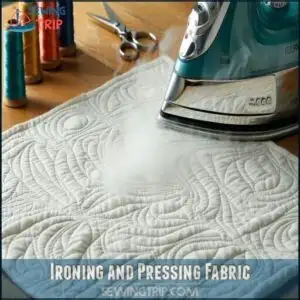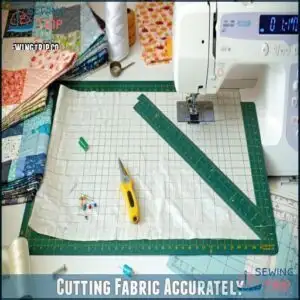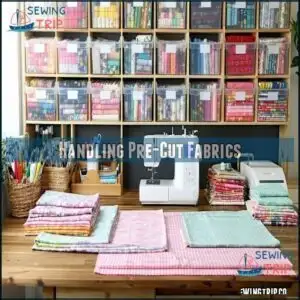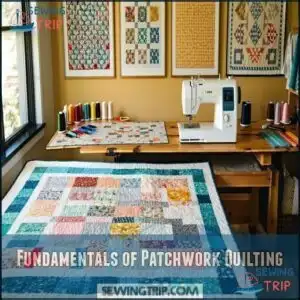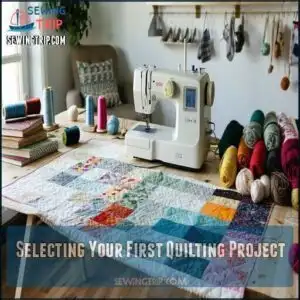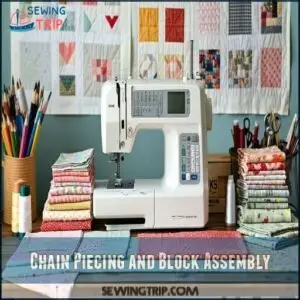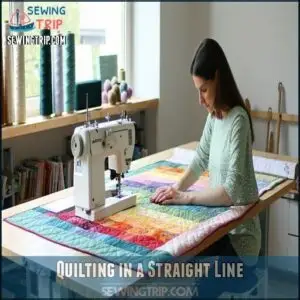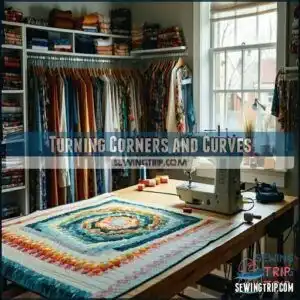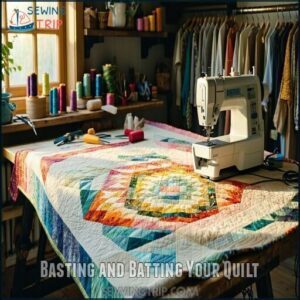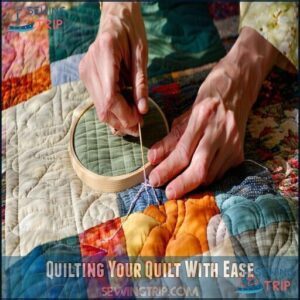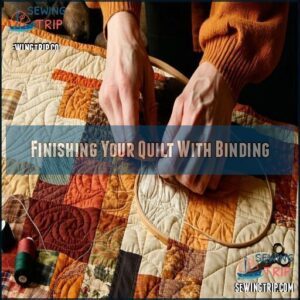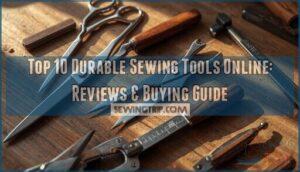This site is supported by our readers. We may earn a commission, at no cost to you, if you purchase through links.
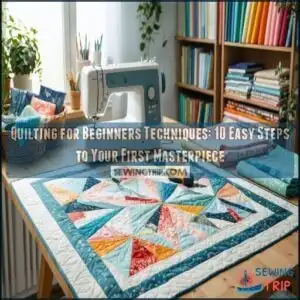
Focus on learning straight-line stitching and sewing a quarter-inch seam—these are your bread and butter.
Use 100% cotton fabric; it’s forgiving and easy to work with. Pre-wash it to avoid surprises later (shrinking quilts aren’t fun).
Get comfy with basic tools like rotary cutters, mats, and a trusty sewing machine. Practice piecing blocks and pressing seams in one direction—it’s like ironing shirts but more fun.
Ready to stitch your first masterpiece? There’s more to uncover as you go!
Table Of Contents
- Key Takeaways
- Choosing The Right Fabric for Quilting
- Essential Quilting Tools and Supplies
- Preparing Your Fabric for Quilting
- Fundamentals of Patchwork Quilting
- Selecting Your First Quilting Project
- Mastering Basic Quilting Techniques
- Understanding Quilting Patterns and Designs
- Basting and Batting Your Quilt
- Quilting Your Quilt With Ease
- Finishing Your Quilt With Binding
- Frequently Asked Questions (FAQs)
- Conclusion
Key Takeaways
- Focus on mastering straight-line stitching and a quarter-inch seam for neat and accurate quilting results.
- Use 100% pre-washed cotton fabric and quality tools like rotary cutters and mats to make the process easier.
- Start with simple patterns like patchwork or nine-patch and practice pressing seams to one side for better alignment.
- Keep mistakes in perspective—they’re learning opportunities, not failures, in your quilting journey.
Choosing The Right Fabric for Quilting
You’ll find that selecting the right fabric makes all the difference in creating a quilt you’ll love for years to come.
The right fabric choice transforms your quilt into a timeless treasure you’ll cherish for years.
With so many options available, from cotton prints to solids, you’ll want to choose fabrics that both catch your eye and work well together for your specific quilting project.
Types of Cotton Fabric
The right cotton fabric forms the foundation of your quilting journey.
When selecting your materials, focus on these key varieties:
- Quilting cotton – Medium-weight with tight weaves, perfect for beginners
- Cotton blends – Offer easier handling with added polyester or linen
- Batiks – Densely woven with beautiful dye patterns
- Flannel – Soft with a brushed surface for cozy quilts
Each type brings unique characteristics to your creative process.
Before starting, consider pre washing fabrics to guarantee the best results.
Selecting Fabric Patterns and Colors
Now that you’re familiar with cotton fabric types, let’s talk about selecting patterns and colors.
When choosing fabric for your first quilt, think about color theory basics and how different fabrics work together.
Consider color value (light to dark) to create depth, and experiment with pattern mixing like florals with geometrics.
Remember, quilting patterns often look best when you balance bold prints with quieter fabrics, and trust your instincts—your personal taste matters most!
Pre-Washing and Pre-Shrinking Fabric
Now that you’ve selected your fabric patterns and colors, let’s talk about pre-washing.
Before cutting your first piece, wash your fabrics to prevent future surprises.
Fabric shrinkage and color bleeding can ruin your finished quilt! Use mild detergent in cold water, then dry and press thoroughly.
This simple fabric preparation step guarantees your quilting for beginners project maintains its shape and vibrancy for years to come. Your prewashed fabrics will thank you!
Essential Quilting Tools and Supplies
You’ll need the right tools to make your quilting journey smooth and enjoyable.
From rotary cutters and quality needles to a reliable sewing machine, having these essentials on hand will help you create beautiful quilts.
Without the frustration that comes from using makeshift supplies, you can focus on your craft, and having the right tools is key to this process.
Rotary Cutters and Mats
In the realm of quilting, rotary cutters and mats serve as the foundation for precision cutting. These essential tools transform fabric preparation from tedious to enjoyable. A wide selection of rotary cutter products are available for purchase.
- Choose the right size – 45mm rotary cutters work well for most projects
- Practice proper technique – cut away from your body using firm, even pressure
- Replace blades regularly – dull blades tear fabric and require more force
- Store cutters safely – always engage the safety lock when not in use
- Clean your mat regularly – wipe with mild soap and water, avoiding harsh chemicals
You’ll achieve crisp, accurate cuts when you maintain sharp blades and keep your self-healing mat flat and clean. Remember to always prioritize cutter safety by keeping fingers well away from the blade path.
Sewing Machines and Accessories
Your sewing machine’s capabilities are essential to your quilting journey. Choose machines with needle-down functions and adequate space for large projects.
A walking foot attachment helps navigate thick layers without puckering, while different machine feet accommodate various techniques. Adjust sewing speed and tension control for precise stitching—slower is often better for beginners.
Remember to maintain your quilting machine regularly; clean the bobbin area after each project. Pair your machine with quality thread types that complement your fabric.
Basic models work fine for beginners, but specialized quilting machines offer enhanced features as your skills grow. To achieve professional results, understand the importance of a quilt sandwich construction for smooth stitching.
Quilting Needles and Threads
Now that you’ve got your sewing machine ready, let’s talk about quilting needles and threads. Your selection here can make or break your quilting project!
For beginners, choose between size 12-14 quilting needles for most fabrics. Cotton threads work beautifully for quilting stitches.
- Thread colors can transform your quilt from ordinary to extraordinary
- Quality needle materials prevent frustrating breakage when you’re in the flow
- The right thread types create those satisfying, even stitches you’ll proudly show off
Match thread weight to your fabric thickness for best results.
Quilting Hoops and Frames
Quilting hoops and frames are must-haves for beginner quilting.
Hoop sizes or frame types should be chosen based on your quilt’s needs, and quilting stands are key for comfort.
Quilting hoops offer portability—perfect for quilting basics on the go—while frames provide stability for larger projects.
Maintain your tools well, and you’ll master these essential quilting supplies in no time!
Preparing Your Fabric for Quilting
Getting your fabric ready is a vital step that sets the tone for your quilt’s success.
A little prep work, like ironing and cutting accurately, saves you time and frustration later.
Ironing and Pressing Fabric
Wrinkles don’t stand a chance with proper pressing techniques! First, know your temperature settings—too hot, and your fabric might scorch.
Deciding between steam vs dry? Steam softens stubborn wrinkles, while dry pressing works wonders for delicate fabrics.
Press steadily, lifting the iron instead of sliding to avoid stretching.
For beginner quilting, practice pressing seam allowances flat—it’s a game-changer for neat, professional results.
Master this, and you’re sewing like a pro!
Cutting Fabric Accurately
Laying your fabric on a cutting mat, aim for accurate measurements. Grab a rotary cutter and ruler—they’re your best friends here.
Always follow the fabric grain for clean cuts and better alignment. Remember: measure twice, cut once!
For precision:
- Use rotary cutting tools for smooth edges.
- Verify each template matches your fabric’s layout.
- Add a quarter-inch seam allowance—it’s the secret sauce!
Sharper tools = better results. Happy cutting!
Handling Pre-Cut Fabrics
Precut fabrics are a beginner quilting dream—imagine skipping the fuss of cutting.
Organize your fabric selection thoughtfully: store bundles like fat quarters in clear, labeled bins for easy access.
Sorting fabric early keeps you focused later.
Precut tips? Stabilizing fabric edges prevents fraying during stitching.
Remember, while versatile, these cuts may shape your design choices.
With solid cut fabric management, beginner quilting feels less overwhelming, making precut fabrics a true timesaving ally.
Fundamentals of Patchwork Quilting
Patchwork quilting is all about sewing small pieces of fabric together to create beautiful patterns, and it’s easier than it looks.
With a steady quarter-inch seam, pressed seams, and a few basic blocks, you’ll be piecing like a pro in no time.
Sewing a Quarter-Inch Seam
Nailing that quarter-inch seam allowance is a game-changer for any quilter.
It’s all about precision, and the payoff is well worth it! Here’s how you can master it:
- Set up a seam guide on your machine to keep your stitching on track.
- Practice stitching on fabric scraps—it’s a low-stress way to build confidence.
Always respect the fabric grain and cut accurately.
Getting consistent seams guarantees your quilt blocks align beautifully. Combine this with proper stitch length and you’ll have smooth, pro-level results.
Relax—perfection comes with practice!
Pressing Seams in One Direction
Pressing seams in one direction is a simple trick that takes your quilt from good to great.
It reduces bulk, keeps fabric tidy, and improves alignment—a win-win for quilting basics.
Use these tips below to master the art:
Ironing Tips Seam Direction Pressing Order
Remember: consistent seam direction makes sewing techniques easier and creates polished results.
Relax—your quilt will thank you!
Mastering Standard Patchwork Blocks
Once your seams are pressed, it’s time to explore the magic of quilt blocks!
These classics bring life to your quilt, offering endless creative options.
Master these standard designs:
- Nine-patch: Simplest for beginners—a quilting favorite.
- Log cabin: Layers like tree rings; versatile and timeless.
- Half-square triangle: Bold, yet beginner-friendly.
- Flying geese: Dynamic and eye-catching additions.
- Rail fence: Straightforward, perfect for patchwork tips!
Enjoy experimenting with different block patterns to build skills.
Selecting Your First Quilting Project
Picking your first quilting project can feel like standing in front of a candy store, not sure which treat to grab.
Start small with something simple, so you can enjoy the process without feeling overwhelmed.
Lap Quilts for Beginners
Starting with lap quilts is perfect for beginner quilting—they’re small, manageable, and fun!
Stick to easy patterns with squares or strips, and focus on fabric selection alongside the right quilting threads.
For more detailed guidance, explore these essential quilting supplies.
Lap quilt sizes let you practice quilt layering without stress.
Follow basic quilting techniques and treat each step as a learning moment.
With these beginner tips, you’ll sew cozy, confidence-boosting projects that are just as rewarding as they’re stylish!
Baby Quilts and Wall Hangings
Baby quilts and wall hangings make perfect beginner projects—fun, practical, and easy to customize!
Baby quilt sizes are small and manageable, while wall hanging ideas let you showcase creative flair.
Need inspiration? Here’s a guide:
- Explore nursery themes for adorable motifs.
- Use wall-size quilt patterns for practice.
- Try quilt border designs for stylish finishes.
- Craft baby blankets with bold colors.
- Look into easy quilts for foolproof success.
Enjoy quilting for beginners with confidence!
Choosing Projects Based on Skill Level
Picking projects by skill level keeps beginner quilters motivated without feeling overwhelmed.
It’s all about balancing the learning curve with fun and creativity. Start simple and embrace growth as you go.
- Lap Quilts: These easy quilts are quick to finish, teaching project complexity and skill assessment.
- Placemats: Perfect for beginner sewing, they blend fun patterns with short time commitments.
- Mini Wall Hangings: Great for exploring material selection and testing diverse techniques on a smaller canvas.
Enjoy creating beginner quilts at your own pace—one stitch at a time!
Mastering Basic Quilting Techniques
You’ll be amazed at how quickly you can pick up basic quilting techniques with a little practice.
From chain piecing to turning corners, these skills will make your quilting projects come together smoothly.
Chain Piecing and Block Assembly
Imagine your sewing area buzzing with efficiency—welcome to chain piecing! This quilting-for-beginners technique connects fabric pieces in a continuous strand, saving time and thread.
Block assembly methods, like nested chain piecing, guarantee everything stays organized. Sub-unit construction helps build your final blocks seamlessly, avoiding twisted seams.
Keep design considerations in mind while stitching—it’s like building a puzzle one row at a time. Quilting tutorials often call this the secret to smooth, stress-free patchwork quilting!
Quilting in a Straight Line
Quilting in a straight line is a cornerstone skill every beginner quilter needs.
With the right tools and patience, you’ll master it in no time.
Here’s what helps:
- Walking foot: Keeps fabric layers from shifting.
- Quilting rulers: Guarantees edge alignment and precision.
- Guided stitching tools: Maintain straight quilting stitches effortlessly.
- Fabric tension checks: Avoids puckering issues.
- Quilting tutorials: Perfect for learning beginner quilting squares by hand.
Stay steady, and enjoy each stitch!
Turning Corners and Curves
Precision in curve sewing and corner clips makes quilts shine.
For clean Pivot Turns, stop with the needle down, lift the presser foot, then rotate fabric effortlessly.
Seam Navigation works best with marked allowances, while Radius Cutting tools help smooth arcs.
Keep quilting stitches even by guiding gently—skip the rush! Press bulky seams flat for tidy layers.
Beginner quilting squares by hand? Master curves, and they’ll look polished. Free quilting tips for beginners: skillful corners elevate every project!
Understanding Quilting Patterns and Designs
Quilting patterns and designs might seem tricky at first, but they’re your secret to creating something truly unique.
Don’t worry—once you break it down, you’ll see they’re easier to follow than the Sunday crossword!
Creating Your Own Quilt Design
Creating your own quilt design is where your creativity truly shines. Start by sketching a vision—let quilting inspiration flow from nature, favorite books, or even beginner wall-size quilt patterns. Don’t agonize over perfect color schemes; quilts thrive on personality, not perfection.
Here’s how to get started:
- Play with Color Schemes: Use swatches to mix and match hues that spark joy.
- Explore Design Principles: Balance, contrast, and rhythm make your quilt visually stunning.
- Plan a Quilt Layout: Chart block patterns like a puzzle, arranging them until it feels right.
- Nail Fabric Selection: Hunt for textures and prints that complement your theme.
- Test with Software: Free quilt design tools preview your masterpiece before you cut or sew.
Each block tells a story—make it worth stitching!
Choosing Quilting Patterns for Beginners
Got your quilt design ready? Now it’s time to pick quilt patterns that match your skill level.
Simple patterns like the nine-patch or rail fence are beginner favorites—they’re easy to follow, teach accuracy, and keep things stress-free. Starting small? Try pattern sizes like baby or lap quilts; they’re manageable and perfect for learning.
Explore free patterns or pre-cut pattern kits online—they save time and take guessing out of cutting. Look for “beginner quilt patterns” in your searches. Trust us, they’ll make the process smoother.
A beginners guide encourages experimenting with colors and prints while building confidence. With an easy quilting technique for beginners, you’ll stitch something special without breaking a sweat!
Basting and Batting Your Quilt
Basting and batting are what bring your quilt layers together and give it that cozy feel.
Don’t worry—it’s easier than it sounds, and with a little patience, you’ll get it just right!
Choosing The Right Batting
Think of batting as the soul of your quilt. It affects warmth, texture, and durability. Start with the basics: loft, fiber content, and batting size.
Batting is the heart of your quilt, adding warmth, texture, and durability to bring your creation to life.
- Low-loft batting keeps it sleek; high-loft adds serious fluff.
- Cotton feels natural and soft; polyester resists wrinkles and holds shape.
- Prepackaged sizes save time, or cut yardage to fit.
Choosing the right cotton batting is essential for a successful quilt. Choose wisely—batting ties your hard work together, from prewashing fabrics to the final quilt binding!
Basting Techniques for Quilts
Basting is your quilt’s secret glue, holding layers steady for the quilting ahead.
Popular basting methods include spray adhesives, pin basting, and hand tacking.
Safety pins work wonders for beginners, keeping that quilt sandwich snug—no slipping!
Prefer a faster option? Machine basting or sprays are lifesavers.
Whichever technique fits you, focus on securing the fabric evenly.
Mastering these beginner quilting techniques guarantees your masterpiece stays beautiful, one stitch at a time, with proper basting.
Preparing Your Quilt for Quilting
Your quilt top’s ready—now comes the exciting part: preparing your quilt for quilting!
Start by spreading your quilt backing flat on a surface, smoothing wrinkles. Add batting (the cozy “heart” of your quilt), picking materials like cotton, wool, or silk for warmth and texture.
Lay your quilt top, right side up, completing your “quilt sandwich.” Secure everything with safety pins or basting spray.
Basting is essential for successful quilting projects. This step guarantees no shifting while stitching your masterpiece.
Whether you’re tackling simple beginner wall-size quilt patterns or larger projects, proper fabric preparation and quilt layering set the stage for flawless stitching and successful quilting results!
Quilting Your Quilt With Ease
Quilting your quilt might sound tricky at first, but it’s easier than you think with the right techniques.
Whether you’re stitching by hand or using a sewing machine, you’ll soon see your quilt come to life, one stitch at a time.
Machine Quilting Basics
Machine quilting can feel intimidating, but it’s simpler than it looks! Start by adjusting machine tension and practicing on scraps. Use a walking foot for smooth fabric feed or a quilting foot for curves and creativity.
- Match thread choice to your fabric.
- Keep your stitch length consistent.
- Find a comfortable quilting speed.
Beginner wall-size quilt patterns are a great start—just relax, enjoy, and treat mistakes as learning moments.
Hand Quilting Techniques
Hand quilting offers an old-school charm, combining patience with artistry.
Choose a hand quilting frame or hoop that feels natural to hold. Use sharp quilting needles and thimbles to protect your fingers while stitching.
Start with a simple running stitch, keeping thread tension even—it’s foundational for quilting by hand. Practice "hand quilting beginning a line" slowly, and you’ll master the basics of quilting, one stitch at a time.
Understanding basic hand quilting techniques is essential for creating beautiful quilts. Stay steady and enjoy the process of hand quilting.
Quilting in a Pattern or Design
Let’s explore quilting designs and discover your creativity! Start with simple block patterns to build confidence.
Playing with fabric layouts and design principles can transform even basic quilts.
Try this:
- Experiment with color schemes and quilt motifs for unique vibes.
- Mix traditional quilt patterns with modern twists to keep things fresh.
- Explore online quilting techniques and free motion quilting tutorials for new ideas.
Patchwork offers endless possibilities; soon, you’ll design masterpieces that reflect your style!
Finishing Your Quilt With Binding
Binding is the final step that gives your quilt a polished, finished look, while keeping the edges secure.
Don’t worry—it’s easier than it sounds, and you’ll feel so proud when it’s done!
Making and Sewing Binding
A great quilt deserves a strong finish, and binding is the cherry on top.
Here’s how:
- Choose binding style: Double-fold is durable; single-fold is lightweight.
- Cut fabric strips: Use straight or bias binding, typically 2.5 inches wide.
- Sew to edge: Attach binding, leaving crisp, mitered corners.
- Finish by hand: Fold over neatly and secure with hidden stitches for polished edge finishing.
Adding Embellishments and Appliqué
Adding embellishments and appliqué transforms your quilt into a storybook of creativity.
Whether you’re attaching beads, buttons, or mastering quilt applique techniques, think of each detail as the “jewelry” for your quilt.
To achieve a professional finish, understanding sew binding on a quilt is essential for completing your project.
Appliqué Basics: Try raw edge appliqué for quick shapes or needle-turn for a polished look.
With thoughtful design choices, your quilt becomes more than fabric—it’s pure self-expression!
Finishing Touches for Your Quilt
Finish strong by mastering quilt edging and binding techniques! Your final bow brings it all together.
Use fabric trim matching your quilt or try bold contrasts. Mitered binding corners? Don’t stress—it’s easier than you think with practice.
Have fun adding quilt labels for that personal touch. Those little “oops”? Grab your seam ripper and fix them like a pro.
Quilting for beginners becomes quilt finishing magic with these simple steps!
Frequently Asked Questions (FAQs)
What is the easiest technique in quilting?
Everyone raves about the “stitch-in-the-ditch” technique—it’s like training wheels for quilting.
You simply sew along the seams of your quilt’s top layer.
It’s easy, forgiving, and perfect for building confidence without frustration.
What is the golden rule in quilting?
The golden rule in quilting is to measure twice, cut once.
Precision is key!
Take your time, double-check measurements, and align pieces carefully.
A little patience now saves headaches later—trust me, it’s worth it!
What is the basic rule of quilting?
Measure twice, cut once—this simple rule saves you from costly mistakes.
Precision matters in quilting, so take your time, stay patient, and trust the process.
Accuracy now means fewer headaches later.
What is the easiest beginner quilt to make?
A simple patchwork quilt is perfect for beginners.
You just sew together square fabric pieces, like building a puzzle.
It’s straightforward, creative, and forgiving if your seams aren’t perfect—mistakes often add character!
How do I learn to make a quilt?
Start by learning basic quilting terms, gathering essential tools, and watching beginner tutorials.
Practice sewing straight lines and small projects like coasters.
Don’t rush—enjoy the process, and remember, every quilter started as a beginner!
What is the best way to start quilting?
Get started by choosing a simple quilt pattern and assembling essential tools like fabric, rulers, and a sewing machine.
Practice basic stitching techniques, and don’t stress—quilting’s all about progress, not perfection!
Have fun!
What are some tips for quilting?
Keep your workspace tidy and tools organized—it’ll save you headaches.
Use quality fabric and sharp needles for better results.
Practice straight stitches first, and remember, mistakes aren’t failures—they’re just quilting’s way of teaching!
Is quilting easy?
Quilting isn’t hard, but it does take patience.
Think of it like assembling a puzzle with soft pieces.
Start small, practice stitching, and soon you’ll feel confident creating something unique and cozy!
What is the easiest quilting stitch for beginners?
Isn’t it comforting to start simple?
The easiest quilting stitch for beginners is the straight stitch.
It’s reliable, beginner-friendly, and works wonders for piecing fabrics or quilting layers—just sew in straight lines, no stress!
How to fix common quilting mistakes?
Uneven seams? Use a seam ripper; redo them carefully.
Misaligned blocks? Trim them gently or adjust placement.
Quilting too tight? Relax tension.
Embrace imperfections—they add character and tell your quilt’s unique story!
Conclusion
Quilting quickly becomes creative, calming, and confidence-boosting once you’ve mastered these quilting for beginners techniques.
Start with simple steps like sewing straight seams, picking the right fabrics, and getting cozy with your tools.
Practice piecing blocks and pressing seams—it’s like solving a colorful puzzle.
Don’t stress about perfection; each quilt tells a story.
With a bit of patience, you’ll stitch your first masterpiece and be ready to tackle more advanced projects.
Grab your fabric, and let the fun begin!

